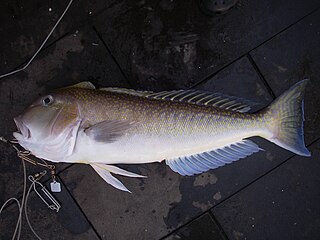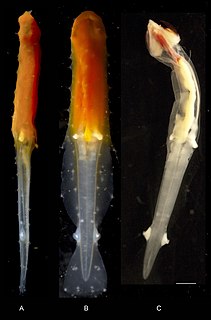Related Research Articles

The Chaetognatha or chaetognaths are a phylum of predatory marine worms that are a major component of plankton worldwide. Commonly known as arrow worms, about 20% of the known Chaetognatha species are benthic, and can attach to algae and rocks. They are found in all marine waters, from surface tropical waters and shallow tide pools to the deep sea and polar regions. Most chaetognaths are transparent and are torpedo shaped, but some deep-sea species are orange. They range in size from 2 to 120 millimetres.

Pelagic fish live in the pelagic zone of ocean or lake waters – being neither close to the bottom nor near the shore – in contrast with demersal fish that do live on or near the bottom, and reef fish that are associated with coral reefs.

A parent to the Florida Current, the Loop Current is a warm ocean current that flows northward between Cuba and the Yucatán Peninsula, moves north into the Gulf of Mexico, loops east and south before exiting to the east through the Florida Straits and joining the Gulf Stream. The Loop Current is an extension of the western boundary current of the North Atlantic subtropical gyre. Serving as the dominant circulation feature in the Eastern Gulf of Mexico, the Loop Currents transports between 23 and 27 sverdrups and reaches maximum flow speeds of from 1.5 to 1.8 meters/second.
Eukrohniidae is a family of sagittoideans in the order Phragmophora. It consists of a single genus, Eukrohnia von Ritter-Záhony, 1909.

The Atlantic threadfin is a species of ray-finned fish a threadfin from the family Polynemidae which is native to subtropical and temperate waters of the western Atlantic Ocean and the Gulf of Mexico.

The giant oarfish is a species of oarfish of the family Regalecidae. It is an oceanodromous species with a worldwide distribution, excluding polar regions. Other common names include Pacific oarfish, king of herrings, ribbonfish, and streamer fish.

The Pacific ladyfish, also known as the Pacific tenpounder and Machete, is a species of fish in the genus Elops, the only genus in the monotypic family Elopidae. The Pacific ladyfish can be found throughout the southwest U.S. and other areas in the Pacific Ocean.

The smooth lanternshark or slender lanternshark is a species of dogfish shark in the family Etmopteridae, found widely in the Atlantic and Pacific Oceans. It inhabits benthic environments at a depth of 274–1,000 m (899–3,281 ft), and pelagic environments at a depth of 0–708 m (0–2,323 ft). The smooth lanternshark forms a species group with the larger blurred lanternshark, both of which are distinguished from other members of their family by small, irregularly arranged dermal denticles with a truncated shape. This species has a slender, dark brown body with an indistinct black band on the sides over the pelvic fins, and reaches 50 cm (20 in) in length. This slow-growing, ovoviviparous shark feeds on smaller squid, fishes, and fish eggs. Smooth lanternsharks are often caught as bycatch in eastern Atlantic and Japanese commercial fisheries. The International Union for Conservation of Nature (IUCN) has evaluated this species as of Least Concern because of its wide distribution and limited threats.

Alatina alata(Reynaud, 1830), often called a sea wasp, is a species of box jellyfish found in the Pacific, Indian and Atlantic Oceans and in the Caribbean and Arabian Sea.

The snowy grouper is a species of marine ray-finned fish, a grouper from the subfamily Epinephelinae which is part of the family Serranidae, which also includes the anthias and sea basses. It is found in the western Atlantic Ocean.

The greater amberjack, also known as the allied kingfish, great amberfish, greater yellowtail, jenny lind, purplish amberjack, rock salmon, sailors choice, yellowtail and yellow trevally, is a species of predatory ray-finned fish in the family Carangidae, the jacks and pompanos. It is found in temperate, subtropical and tropical seas around the world. It is a popular quarry species for recreational fisheries as well as being an important species in commercial fisheries. It is the largest species in the family Carangidae.

The snake mackerel is a species of fish in the monotypic genus Gempylus, belonging to the family Gempylidae. It is found worldwide in tropical and subtropical oceans between the latitudes of 42°N and 40°S; adults are known to stray into temperate waters. It is found to a depth of 600 meters. Populations of the snake mackerel from the Atlantic and the Indo-Pacific differ in vertebral count and number of first dorsal fin spines, and so may represent separate species.

The great northern tilefish or golden tile, is the largest species in the family Malacanthidae (tilefishes), which grows to an average length between 38 to 44 inches. The great northern tilefish is a slow-growing and long-lived species, which has four stages of life. After hatching from eggs, the larvae are found in plankton. As they grow into juveniles, the individuals seek shelter until finding or making their own burrows. As adults, the tilefish continue to expand their burrows in the sediment throughout their lives. The diet of the larvae is unknown, but presumed to consist of zooplankton; juveniles and adults feed upon various benthic invertebrates, crustaceans, and fish. After reaching sexual maturity between 5 and 7 years of age, females lay eggs throughout the mating season for the male to fertilize, with each female laying an average of 2.3 million eggs.

Parasagitta setosa is a small arrow worm in the family Sagittidae, previously referred to as Sagitta setosa. It is native to the northeastern Atlantic Ocean, the North Sea and the Mediterranean Sea, and also occurs in the Baltic Sea and the Black Sea.

Sphyraena chrysotaenia, the yellowstripe barracuda, is a species of predatory, ray finned fish from the family Sphyraenidae which is found in the Indo-West Pacific region. It has entered the Mediterranean Sea from the Red Sea through the Suez Canal as a Lessepesian migrant and is now an important species in the fisheries of the eastern Mediterranean.
Spadellidae is a family of sagittoideans in the order Phragmophora. Spadellidae prey on plankton and commonly reside in the epipelagic zone of the ocean.

Exocoetus obtusirostris, commonly known as the oceanic two-wing flyingfish or the blunt-snouted flyingfish, is a species of ray-finned fish native to the tropical and subtropical western Atlantic Ocean. It has the ability to glide above the surface of the water to escape from predators.

Archeterokrohnia is a genus of chaetognaths in the family Heterokrohniidae.The total body length excluding tail fin 28.5; the tail section is 55.2% of the tail fin; head blunt when hooded, triangular after preservation, head with 3.5 mm. Furthermore, the eyes are absent, the trunk section is orange throughout in life, and the organism exists around 3200 m below sea level.
Caecosagitta macrocephala is a deep sea marine chaetognath that is distributed in meso- and bathypelagic layers. It has a very wide distribution that ranges from the Subantarctic to Subarctic Ocean. Cecosagitta macrocephalas have large heads, hence their name “macro-cephala”. Within their eyes are photoreceptive regions that allow them to catch weak light at bathypelagic depths. Along with their eyes, their gut or intestine has orange pigmentation and a luminous organ that gleams due to bioluminescence unlike some other species of Sagittidae. To be more precise, the luminescent organ is located on the ventral edge of each anterior lateral fin. It is the only member of the genus Caecosagitta, and only one of the two known species of bioluminescent chaetognath, the other being the distantly related Eukrohnia fowleri. C. macrocephala has a secreted bioluminescence that is thought to be coelenterazine based. The luciferase is highly unstable, being unable to survive a single freeze-thaw, and is rapidly inactivated at ice-cold temperatures.
Hemispadella is a genus of chaetognaths in the family Spadellidae. It consists of one species, Hemispadella dauvini Casanova, 1996. The species, as the generic name implies, shares numerous, but not all, of the characteristics of Spadellidae; it shares a number of other characteristics with Heterokrohniidae. The ventral ganglion, poorly described in chaetognaths, is of similar size to the Heterokrohniidae, and the larger number of teeth, and the difference in appearance and function between the anterior and posterior teeth, are similarly characteristic. The relative tail size is similar to that of the Spadellidae, although the overall size is unprecedented among the Spadellidae. The more developed nature of transverse musculature and the basis for the lateral fins are as those of Spadellidae, as well.
References
- 1 2 3 4 5 Casanova, J.-P. (2004). "Calispadella alata n. gen., n. sp., the first chaetognath recorded from a hydrothermal vent site (Mid-Atlantic Ridge)". Journal of Plankton Research. 27 (2): 221–225. doi: 10.1093/plankt/fbh163 . ISSN 1464-3774.
- ↑ Hernández-Flores, R., McLelland, J. & Suárez-Morales, E. (2009). Planktonic Chaetognatha of the Gulf of Mexico. In: Felder, D. L. & Camp, D. K. (eds.), Gulf of Mexico Origin, Waters, and Biota (vol. 1, pp. 1165–1173). College Station: Texas A&M University Press.
| | This Chaetognatha-related article is a stub. You can help Wikipedia by expanding it. |